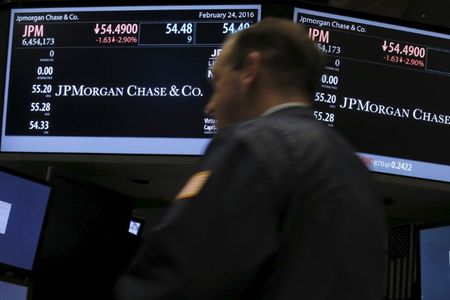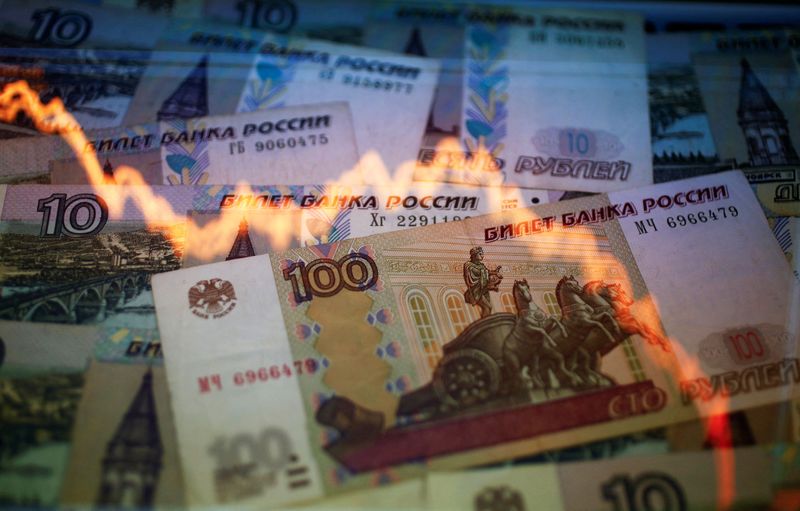After key Russian bond payment, attention turns to next due dates
Reuters
Published Mar 18, 2022 08:22AM ET
Updated Mar 18, 2022 11:50AM ET

By Karin Strohecker and Sujata Rao
LONDON (Reuters) -Russia has paid interest due on two sovereign dollar bonds, easing doubts about its willingness and ability to honour external debt after harsh sanctions imposed by the West, but a busy payment schedule ahead will keep investors on edge.
Failure to pay could have led to Russia's first external bond default in more than a century and was seen as a key test after the sanctions intended to punish Moscow for its invasion of Ukraine.
On Friday, Russia's finance ministry said it had fully met its obligations. Sources involved in the multi-step process of the $117 million coupon payments also confirmed the funds were on their way to creditors.
Some European bond holders said they received funds due in U.S. dollars, while two creditors in Taiwan told Reuters the funds were in the process of being remitted.
"The payment on both coupons has been executed," one source familiar with the situation said.
The coupons were due on Wednesday but Russia had a 30-day grace period for the payment, which must be received in full and in the right currency to avoid default.
News of the payment lifted Russian bond prices, with the 2043 bond, one of the issues on which a coupon had been due, rising to 45 cents in the dollar.
While trading volumes were thin, that marked a rise from a record low of 12 cents hit on March 8, Refinitiv data shows.
Russia has around $40 billion of external bonds outstanding, half of which are held by foreign investors. It was not clear if domestic holders of the bonds, which include some of the country's biggest lenders, had received payments.
However, this week's payments are the first of many Russia must make to preserve its complex web of external borrowing.
It must pay another $615 million in coupons this month while on April 4, a hefty $2 billion bond must be repaid. In total, more than $4.5 billion in coupons and maturities are due by year-end.
One complication is that Eurobonds placed after 2014 -- the year Russia first came under sanctions for annexing Crimea -- allow for payment in alternative currencies such as euros and pounds.
And the next international coupon due March 21 is a $66 million payment on a 2029 dollar bond, which like others sold after 2018, lists the rouble as an alternative currency option. It too has a 30-day grace period.
JPMorgan (NYSE:JPM) analyst Jonny Goulden said upcoming payments may treat investors differently "either because those bonds are cleared via the Russian NSD settlement mechanism or because they have a rouble fallback as a payment currency, which the Russian government may look to pay in roubles."
POST-MAY 24 BONDS
But questions have arisen on what happens to Russian bonds maturing after May 24.
The U.S. Office of Foreign Assets Control (OFAC) issued general license 9A on March 2, authorising U.S. persons to receive dividends and bond payments on Russian securities from the finance ministry, central bank or national wealth fund -- all of which are under sanctions.
That exemption runs out on May 25, leaving in balance nearly $2 billion in external sovereign bond payments due until end-2022.
Christopher Granville, managing director at TS Lombard reckons the flow of money will continue, with further OFAC exemptions likely.

"It's safe to say it will be remain manually controlled, intermediaries will be able to apply for exemptions and if Russia allows payments, why would they want U.S. creditors to suffer?" Granville said.
"Also the payments will hurt Russia by eating into their hard currency reserves."
Written By: Reuters
Trading in financial instruments and/or cryptocurrencies involves high risks including the risk of losing some, or all, of your investment amount, and may not be suitable for all investors. Prices of cryptocurrencies are extremely volatile and may be affected by external factors such as financial, regulatory or political events. Trading on margin increases the financial risks.
Before deciding to trade in financial instrument or cryptocurrencies you should be fully informed of the risks and costs associated with trading the financial markets, carefully consider your investment objectives, level of experience, and risk appetite, and seek professional advice where needed.
Fusion Media would like to remind you that the data contained in this website is not necessarily real-time nor accurate. The data and prices on the website are not necessarily provided by any market or exchange, but may be provided by market makers, and so prices may not be accurate and may differ from the actual price at any given market, meaning prices are indicative and not appropriate for trading purposes. Fusion Media and any provider of the data contained in this website will not accept liability for any loss or damage as a result of your trading, or your reliance on the information contained within this website.
It is prohibited to use, store, reproduce, display, modify, transmit or distribute the data contained in this website without the explicit prior written permission of Fusion Media and/or the data provider. All intellectual property rights are reserved by the providers and/or the exchange providing the data contained in this website.
Fusion Media may be compensated by the advertisers that appear on the website, based on your interaction with the advertisements or advertisers.